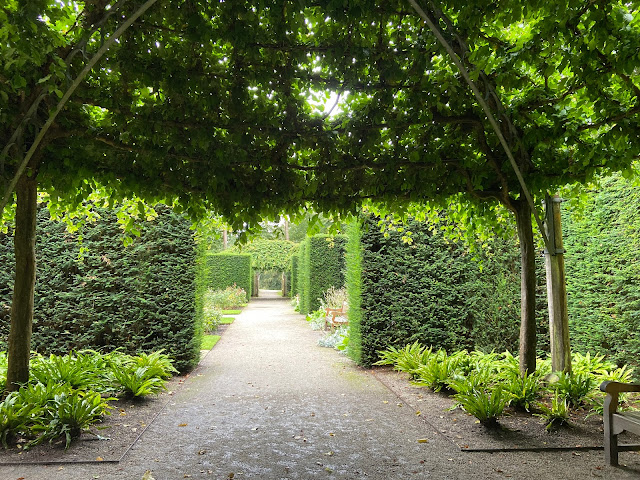In the last post the roses featured were mainly in the warm tones of peach and burgundy. This selection consists of roses in the more classic shades of pink and white. The weather has warmed up this week, and the roses are continuing to look and smell beautiful.
 |
| Queen of Sweden in foreground with Iceberg behind |
The rose above is a David Austin rose called Queen of Sweden. What charming cup shaped flowers it has. They are a soft pink neither too cool nor too warm, but capable of sitting happily with most other shades. In growth it is upright in habit, bearing its flowers at the top of the bush. It can therefore sit behind a lower growing perennial a little way back in the border.
 |
| Close up of Queen of Sweden |
 |
Rosa Bonica with Geranium Buxton Blue
|
I have a bed planted with five Rosa Bonica interspersed with Geranium Buxton Blue. Bonica is a modern shrub rose, not very tall at 1.2m high. Quite how the geranium manages to reach the same height I don't know. Perhaps its the rose feed that makes it grow so. I love that combination of lavender blue with the pale to mid pink of the rose. Its flowers are held in dainty sprays, clothing the rounded bush all over. Its a good healthy rose which doesn't seem to suffer from black spot or other problems. It also keeps on flowering throughout the summer.
 |
| Rosa Bonica |
Moving on to a white rose, this is Margaret Merrill. She is a floribunda with such pretty stamens in the centre. Some floribundas produce so many flowers closely together that they appear a little bit squashed. Not so with Margaret Merrill. Some of the flowers are held in small clusters and others appear singly. The blooms are of a good size - about 10 cm across. I chose this rose because of its scent and the round central bed in the rose garden is filled with these.
 |
| Rosa Margaret Merrill |
Do you want a rose that reminds you of blackcurrant ripple ice cream? Indeed, who wouldn't? Ferdinand Pichard has flowers in pale pink stripped with crimson and purple, shaped like little round scoops of ice cream. It has a good fragrance too with hints of lemon mixed with classic rose. Ferdinand is an Hybrid Perpetual rose bred in 1910. It can be pruned to a 1.2m high bush, but it also likes to go a little taller with some support, as it is here where it is covering the lower reaches of a rose arbour.
 |
| Rosa Ferdinand Pichard |
 |
| Close up of Ferdinand Pichard |
If you are after a rose that is very disease resistant then Rosa Queen of Denmark (Konigin von Danemark) would be a good choice. I believe that Alba roses, of which this is one, do not suffer from black spot and any of those nasties. Queen of Denmark is a large lady, as one might expect of a monarch, and will grow into a bush about 1.5m high and just as wide. She is a true rose garden classic with a strong old rose perfume and charming quartered rosette flowers.
 |
Rosa Queen of Denmark above and below
If there is one floribunda rose that most people are familiar with, it is Iceberg. It is widely grown and it is easy to see why. It flowers and flowers and flowers. It just keeps on going. Its double flowers of pure white are very pretty. It can be pruned hard to form a bush, like those in the picture above or pruned less vigorously to make a larger shrub, as I have done elsewhere in the garden. These bushes were moved from their previous position in late winter and I am pleased with how well they have settled down. Those bushes that were pruned less hard have now got so much top growth that they will need some serious supporting to hold their stems up, so I think in future they will all be getting a proper hard pruning. Below is a close up of one of the blooms partially open.

Iceberg has been around since 1958, but the rose below is much more recent, dating back only to 2006, when it won Rose of the Year. I won't tell you what it is called just yet in case it puts you off. I would recommend it for its pretty creamy off white colour tinged with apricot. Its flowers are shallow cups with swirls of petals in the centre.
The bush is fairly upright and about 1.2m tall. It repeat flowers well and it doesn't succumb to black spot or other diseases. It was bred by Kordes, a German rose breeder, who stopped using fungicide on their trial fields some years ago. As a result many of their roses suffered from fungal diseases, but those that didn't were selected to form the basis of their ongoing breeding programme, meaning that their roses are very healthy.
The name of this lovely rose is Champagne Moment.
And finally for this post, a climbing rose called Madame Alfred Carriere. She is a noisette rose whose blooms are soft cream to pale pink. It smells good too. This is an East wall that it is growing on and it gets very little direct sun due to the yew trees growing nearby. So its not doing too badly given that many roses would heartily dislike this position. This was pruned (honest), but could now do with some more tying in.
|
A close up of a bloom from Madame Alfred Carriere.

















Comments
Post a Comment